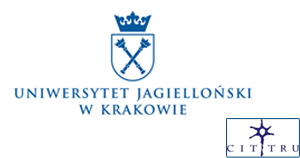ul. Bobrzyńskiego 14
30-348 Kraków
Główny telefon: +48 12 664 42 00
Główny email: cittru@uj.edu.pl
Strona www: www.cittru.uj.edu.pl
Wyślij zapytanie ofertowe
Therapeutic area
Alzheimer's disease is a progressive neurodegenerative disorder characterised by decline in cognitive functions. Currently, the available pharmacotherapy only offers symptomatic relief, with moderate effectiveness. Significantly, no new medicine has been developed and introduced over the past 17 years, and numerous clinical trials for both disease-modifying treatments and symptomatic treatments have been unsuccessful.
Scientific Hipotesis
Multi-target directed ligands (MTDLs) for the potential use in the treatment of Alzheimer's disease are the subject of this offer. These new compounds possess the ability to interact with Alzheimer’s disease by modifying its course as well as alleviating its symptoms through effectively inhibiting the butyrylcholinesterase (BuChE) and β-secretase enzymes and preventing the aggregation of β-amyloid. The new compounds were designed according to the concept of multifunctional ligands. This term refers to molecules which can be directed at multiple biological targets and/or mechanisms of pathogenicity associated with the same disease.
Lead compound
JT-3 Compound: the subject of the invention, has been synthesised and its multifunctional biological effects were confirmed in in vitro studies, namely, its potential to inhibit the butyrylcholinesterase and β-secretase enzymes and to prevent the aggregation of β-amyloid.
In vivo pilot studies on animals have demonstrated the efficacy of the test compound in models for improving memory impairment. Compound JT-3 shows an improvement in memory processes in mice using the passive avoidance test, Morris water maze and Barnes maze test. The results of biological tests indicate their therapeutic potential in the treatment of neurodegenerative diseases, particularly Alzheimer’s disease.
Obszar terapeutyczny
Choroba Alzheimera jest postępującym zaburzeniem neurodegeneracyjnym charakteryzującym się pogorszeniem funkcji poznawczych. Obecnie dostępna farmakoterapia daje jedynie na łagodzenie objawów dodatkowo charateryzując się umiarkowaną skutecznością. Co istotne, w ciągu ostatnich 17 lat nie opracowano i nie wprowadzono żadnego nowego leku, a liczne badania kliniczne dotyczące zarówno leczenia modyfikującego przebieg choroby, jak i leczenia objawowego zakończyły się niepowodzeniem.
Hipoteza naukowa
Przedmiotem tej oferty są ligandy ukierunkowane na wiele celów (MTDL) do potencjalnego zastosowania w leczeniu choroby Alzheimera. Te nowe związki działają poprzez modyfikację przebiegu choroby, a także łagodzenie jej objawów poprzez skuteczne hamowanie enzymów butyrylocholinesterazy (BuChE) i β-sekretazy oraz zapobieganie agregacji β-amyloidu. Nowe związki zostały zaprojektowane zgodnie z koncepcją wielofunkcyjnych ligandów. Termin ten odnosi się do cząsteczek, które mogą być skierowane na wiele biologicznych celów i/lub mechanizmów patogenności związanych z tą samą chorobą.
Związek wiodący
Związek JT-3: przedmiot wynalazku został zsyntetyzowany, a jego wielofunkcyjne efekty biologiczne potwierdzono w badaniach in vitro, a mianowicie jego potencjał hamowania enzymów butyrylocholinesterazy i β-sekretazy oraz zapobiegania agregacji β-amyloidu.
Badania pilotażowe in vivo na zwierzętach wykazały skuteczność badanego związku w modelach poprawy upośledzenia pamięci. Związek JT-3 wykazuje poprawę procesów pamięciowych u myszy przy użyciu testu biernego unikania, labiryntu wodnego Morrisa oraz testu labiryntu Barnesa. Wyniki badań biologicznych wskazują na ich potencjał terapeutyczny w leczeniu chorób neurodegeneracyjnych, w szczególności choroby Alzheimera.